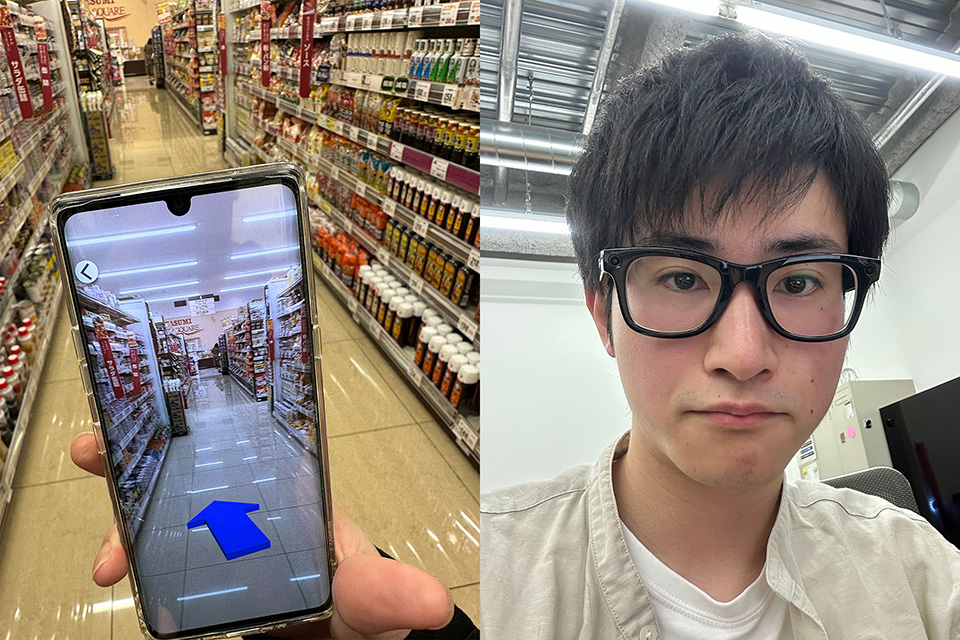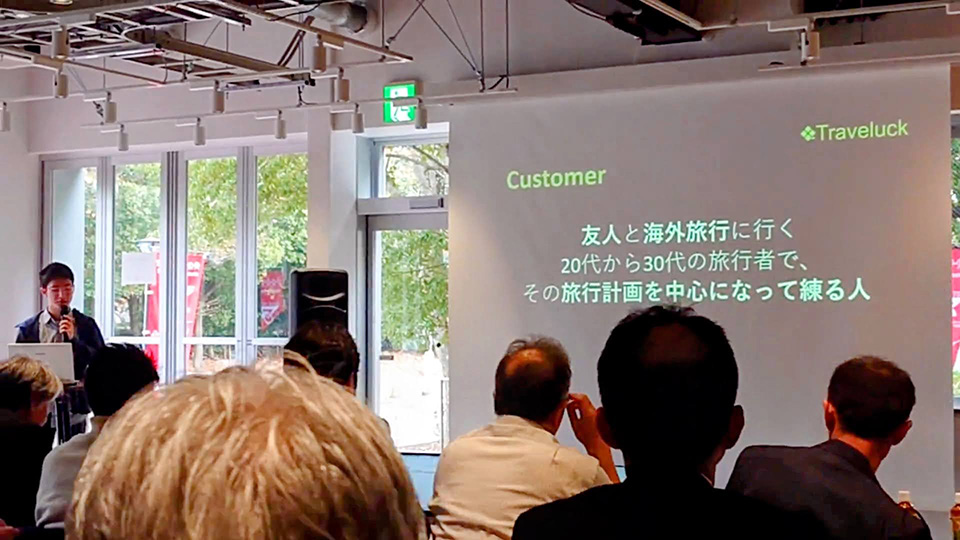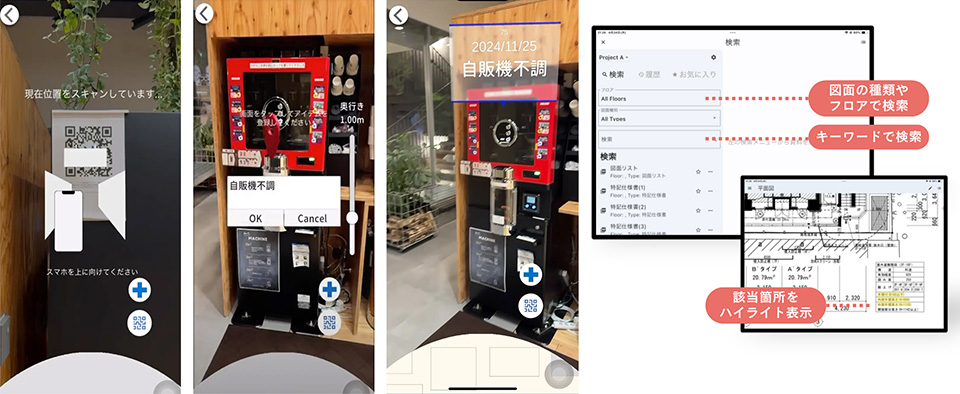- TOP
- About
- Affiliated League
- Information
- League Members
- Partners
- League Report
Search League Members
-
公式X
From smartphone apps to AR smart glasses—
Shota Imamura, CEO of Nefront Inc., is currently 25 years old. He founded the company four years ago, during his third year of university.
Having experienced the huge wave of smartphones in his youth, Mr. Imamura was quick to notice the expanding market and potential of AR. He has developed and provides "IndooAR," an indoor AR cloud service that can identify location information even inside buildings where GPS signals are weak.
Furthermore, looking ahead to the global adoption of smart glasses equipped with AR functionality, he aims to build a spatial information platform.
 Left: Initially, they explored its use for providing directions in commercial facilities. A prototype was developed that could guide users to desired products by matching their in-store location with pre-scanned images.
Left: Initially, they explored its use for providing directions in commercial facilities. A prototype was developed that could guide users to desired products by matching their in-store location with pre-scanned images.When did you first become interested in your current field of business?
Imamura: I was born in 2000, so I'm from the generation that saw the iPhone emerge during childhood. By the time I was in junior high, LINE came out and everyone started using it, so I begged my parents to buy me a smartphone.
In elementary school, I read biographies of Masayoshi Son and Steve Jobs from my father's study and was deeply impressed to learn how businesses were created during the dawn of the internet and personal computers. After that, I witnessed the incredible wave of smartphones rapidly expanding during my curious adolescent years. This made me want to create new services and applications and spread them to the world.
Why did you choose to study computer science at the University of Tsukuba?
Imamura: Actually, I experienced some setbacks in high school. In my first and second years, I tried to build my own applications, but I couldn't get them to work properly. I also planned and ran a biannual school event, inviting dozens of guest speakers—including a former prime minister, company executives, software developers, and creators—to support the students. We gathered about 5,000 people each time. I've always loved launching and running things, but when technology was involved, it didn't go as I hoped. I wanted to properly understand computer science to bridge the gap between what I wanted to do and what I was capable of.
What made you decide to start a company while you were still in university?
Imamura: In addition to always having the desire to "create my own service and start a business," the University of Tsukuba puts a lot of effort into entrepreneurship education; at the time, it ranked first or second in Japan for the number of startups it produced. From my first year, I took courses where we would pitch startup ideas to external venture capitalists and executives from listed companies, culminating in a final presentation. This made it easy for me to envision launching my own business. In my second year, I had a nine-month internship at ZIGExN Co., Ltd., where I was in charge of a project to create an app version of a website, seeing it through to its business launch.
Then, in my third year, while working on application development, I thought, "Instead of just continuing as an individual developer, I want to create a company and offer my work as a more solid service." I also felt that being a student was the perfect time to take on such a challenge. Being in an environment that allowed me to think that way was a huge factor. If I had gone to a different university, I probably wouldn't have started a business as a student, or perhaps it would have just remained a dream.
How did you decide on the timing for starting your business?
Imamura: Our company was established in June 2021, when I was in my third year of university. The week before, I attended a lecture for students by Tomoko Namba, the Chairman of DeNA Co., Ltd. Hearing her speak, I decided, almost on impulse, "I'm going to start a business right now." At the time, DeNA had systems in place to support employees in starting their own independent businesses, and her message was, "Go out and do interesting things while you're young," and "Even if you fail, you can just try again."
I think the lecture was on a Thursday or Friday, so I ordered the company seal over the weekend. The following week, I went through the articles of incorporation notarization process, and by the first half of the week after that, the company registration was complete. I basically created the company in a flash, in less than ten days from the moment I decided.
 The final presentation for an entrepreneurship course taken in the first year of university. It was his first pitch experience in front of a panel of judges that included founders of listed companies, investors, and the university's vice president.
The final presentation for an entrepreneurship course taken in the first year of university. It was his first pitch experience in front of a panel of judges that included founders of listed companies, investors, and the university's vice president.What led you to develop a business with services that utilize AR?
Imamura: When we started our research and development in the 2020s, the smartphone app market was already saturated, and I believed the era of AR smart glasses was next. Creating the services that would be necessary for that era held the potential to become a world-changing product, and it was also what I had always wanted to do.
From there, how did you proceed to develop the indoor AR cloud service "IndooAR"?
Imamura: When I thought about how to utilize AR technology, at the time it was being used for entertainment and promotions like "Pokémon GO," but its application in more practical apps, such as providing information guidance, hadn't progressed much. For directions, there was Google Maps, but not much beyond that. I figured there must be unresolved problems inside buildings. I thought it would be great to have a service that could identify a user's location within a building, provide information about their surroundings, and offer guidance to solve those problems. That's how I arrived at my current field.
What kind of system is IndooAR, which is currently undergoing proof-of-concept testing and operation?
Imamura: It's a "spatial information management system" that, in indoor environments where GPS is weak, uses a smartphone's camera image and sensor data to pinpoint your current location, enabling guidance to your destination, management of surrounding information, and display of AR content.
Buildings often have many places with similar shapes, making it difficult for existing VPS technology to accurately determine a location. IndooAR overcomes this challenge by using two different indoor positioning technologies: our proprietary VPS method, which can handle such repetitive structures, and an AR marker method for environments with fluid layouts, like exhibitions.
What kind of locations do you envision it being used in?
Imamura: In terms of clients and applications, we are targeting the efficiency of maintenance work for buildings and infrastructure, which are currently facing severe labor shortages. We also envision it for route guidance at event venues and commercial facilities, and for managing goods in supermarkets and warehouses.
It has been implemented at the "Onko Soshin no Mori NOVARE" innovation facility in Koto Ward since May 2025, correct?
Imamura: With support from the Tokyo Metropolitan Government's "Be Smart Tokyo" project for promoting smart service implementation, we were matched with Shimizu Corporation, which owns and operates "Onko Soshin no Mori NOVARE." They are using IndooAR for inspection and repair work within the facility, and in practice, there are parts that are going well and parts that are not. We are currently working with the client to figure out things like how to best integrate existing data, such as inspection records from their previous system, and whether it will function correctly after integration.
Following IndooAR, the other pillar you're developing is the AI blueprint management tool "Filefront," right?
Imamura: Information about buildings is often stored together in paper format. Filefront is a tool designed to streamline the management of such document-based information. It's a system where AI analyzes a vast amount of documents, allowing you to instantly find which blueprint, image, or manual corresponds to which specific location within a building.
We started developing it around spring 2024 while listening to the needs of our clients in the construction and real estate industries, and it's already being used at the sites of several general contractors. In the future, we plan to link it so that data imported with Filefront can be displayed on IndooAR, allowing clients to use them as a set.
 Left: An image showing an inspection report with spatial information being made and displayed in AR via "IndooAR".
Left: An image showing an inspection report with spatial information being made and displayed in AR via "IndooAR".You've been selected for the ICT Startup League for three consecutive terms since FY2023. What have you found most beneficial about participating?
Imamura: In the first year, it wasn't much of a business yet; we were at the stage of, "We're making this interesting product, but...". From there, while sometimes receiving harsh feedback from the judges, we found customers and proceeded with development and initiatives that met their needs. Now in our third year, our proposals have changed considerably, and sales are starting to follow. I feel that if we continue in this direction, we can really establish it as a business.
Also, as Chairman Tadashi Fukuda often says, "Let's all work hard together!" The Startup League isn't just about financial support; it's great that it allows you to connect with other selected participants who share the same ambition. In fact, later today I'm going out for drinks with people I met and became friends with at last year's events and study sessions. We talk about what we've been up to and discuss things like, "How can we use ICT to solve this problem?" I get a lot of inspiration from everyone, thinking things like, "That company is making so much progress."
Please tell us about your future outlook.
Imamura: While steadily advancing our core business of building information management, operational efficiency, and ensuring those services are used effectively, we will also focus our efforts on creating the spatial information platform that we originally set out to build.
From this year to the next, various smart glass devices are being released. However, just having the device isn't enough to get information. The AI, the device, and the application need to understand things like, "What information is available here?", "Where am I right now and what information do I need?", and "What should I do here?" wherever the user goes. We want to build a system that can provide that kind of assistance.
So you're preparing for the coming era.
Imamura: That's right. For example, during building inspection work, you could hear voice instructions in your ear like, "Please check this spot," or "Next, go to this floor," or see them on a display. When you go to a large venue, the route to your target hall or seat could pop up instantly, along with commentary about the event. It's about merging the real space of a building with layers of information like various blueprints, images, and past records, and displaying them together.
Is a future where everyone lives their lives wearing smart glasses getting closer?
Imamura: Meta's AI smart glasses have sold about 2 million units in the US, and a new device with added AR functionality was just announced last week. It's expected that their adoption will rapidly increase to 10-20 million units. We can anticipate that the demand for our platform will grow accordingly.
What kind of executive and engineer do you aspire to be?
Imamura: When smartphones appeared, I was just a bystander and couldn't do anything. But now I'm in the position of a player. This time, I want to ride the wave of change that AR smart glasses will bring, and as both an executive and an engineer, I want to be able to proudly say, "I made this."
Furthermore, I hope to work hard so that in a few years, I can be invited back to a kickoff event and share my story, saying, "I was nurtured by this Startup League, and through hard work, I've come this far."
Editor's Note
Mr. Imamura is thrilled, saying, "With the recent release of AR smart glasses, which I thought were still a year or two away from market, I feel like the future is approaching with audible footsteps." He loves creating new products and possesses excellent judgment, initiative, and an ability to foresee the trends of the times. As a young frontrunner in the coming AR era, great things are expected of his global activities.
@startupleaguejp A video interview with Mr. Imamura of Nefront Inc.! What was the reason he decided to join the Startup League? #StartupLeague #Startup #ConstructionIndustry ♬ original sound - Startup League Official
■ICT Startup League
This is a support program launched in FY2023, originating from the Ministry of Internal Affairs and Communications' "Program to Support R&D for Start-up Creation."
The ICT Startup League supports startups through four pillars.
① R&D Funding / Hands-on Support
Up to 20 million JPY in R&D expenses is provided in the form of subsidies. Additionally, through hands-on support, the selection committee members involved in choosing League members continue to mentor and promote their growth after selection. For companies that a committee member evaluates as a "must-select," a dedicated support system is established where that member personally and continuously provides advice on business plans and offers growth opportunities.
② Discovery & Development
We provide opportunities for learning and networking to promote the business growth of League members. We also work to discover aspiring entrepreneurs to broaden the base of the startup ecosystem.
③ Competition & Co-creation
It provides a positive competitive environment, much like a sports league, where startups learn together and compete constructively to win the funding they truly need (up to 20 million JPY). We also offer a co-creation space where League members can collaborate and expand their businesses through various opportunities, such as sessions with the selection committee.
④ Promotion
We collaborate with the media to publicize the initiatives of our League members! By raising awareness of their businesses, we aim to expand opportunities for new matching and chances.
■Related Websites
Nefront Inc.
/
Nefront Inc. (LEAGUE MEMBER)
/
ICT Startup League